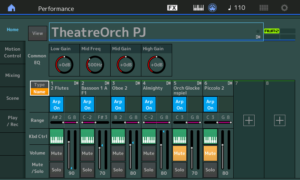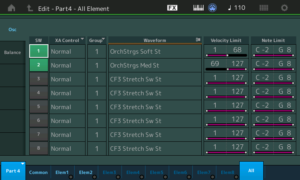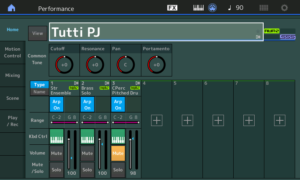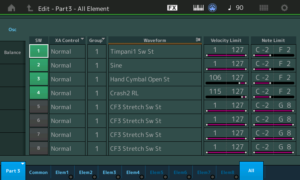Today’s project is reconstructing one of my favorite voices stolen from Genos/PSR: TheatreOrchestra. This voice first appeared in Tyros 3, using waveforms that are roughly contemporaneous with Motif XS (MOX).
The following table summarizes the eight voice elements in TheatreOrchestra. The voice parameters are pulled from the Genos UVF file for the voice.
Element Low High Low High Vol Shift Waveform ------- --- ---- --- ---- ----- ----- ----------------------- 0 C3 G8 1 127 -7.9 0 Flute2 Soft St L (5623) 1 C3 G8 1 127 -9.8 12 Flute2 Soft St L (5623) 2 C3 G8 1 127 -12.0 0 [Flute] (4951) 3 C-2 F#3 1 127 -3.0 -12 Bassoon Hard (5626) 4 E3 G8 1 127 -6.0 -12 Oboe2 Med V3 (5627) 5 C5 G8 1 127 -21.4 24 [Glocken] (5124) 6 C-2 G8 1 68 -9.0 0 p (5248) 7 C-2 G8 69 127 -9.0 0 f (5249)
The volume (element levels) look a little bit curious and I conjecture that element levels are set relative to 0dB. We’ll need to convert these levels to the range [0:127] with 127 corresponding to 0dB. Naturally, we’ll let our ears be the ultimate judge.
The overall sound is dominated by the woodwinds: 3 flute elements, bassoon and oboe. The bassoon and oboe are transposed down one octave. This imparts a unique reedy character to the sound. However, the lower notes (left hand) get somewhat murky, so in the final voice, I leave the bassoon and oboe in their natural ranges to either side of middle C (approximately).
The string component is not strongly stated. Any old string ensemble would do. The waveform names in the UVF files are not super informative although I suspect use of the OrchStrgs waveforms which were introduced in Tyros 3 and Motif XS.
The glockenspiel adds a nice chime to the high end. The glock always sounds in the original Genos/PSR voice, becoming rather tiresome after a while. I prefer to switch the glock in and out. Also, piccolo is a good alternative, again, being switched in and out.
The next table summarized the eight voice elements in Theatre, a similar voice that I constructed for the MOX6.
Element Low High Low High Level Shift Waveform ------- ---- ---- --- ---- ----- ----- ---------------- 1 C2 G8 1 127 90 0 Flute2 Soft St 2 C2 G8 1 127 80 12 Flute2 Med St 3 C3 G8 1 127 40 -12 Flute Non-Vib Of 4 C-2 B2 1 127 100 0 Contrabass R 5 C3 G8 1 127 50 0 Solo Combi St 6 C3 G8 1 127 80 24 Glockenspiel AF2 7 B2 G8 1 127 65 24 Piccolo AF1 8 A#2 G8 1 127 100 0 Oboe 1
The piccolo and glockenspiel are controlled by the Assignable Function buttons AF1 and AF2, respectively. The corresponding element sounds when an AF1 and/or AF2 button is enabled (turned on).
Contrabass and the Motif XS/MOX string Solo Combi replace the string ensemble. The contrabass lends a nice bottom to hold down the bass. It should be played sparsely in the left hand (i.e., no close clusters).
Finally, here is the TheatreOrch voice for MODX. On MOX, I tended to work exclusively in voice mode. MODX is modeless and all programming is made in a Performance. Thus, on MODX, I comp’ed several Performances into a single TheatreOrch Performance, then tweaked the individual Parts. [Click images to enlarge.]
Although Performances are the first class citizens, I still dove into the Parts to make changes at the element level. The string Part is based on the Almighty Performance; I changed the waveforms to OrchStrgs Soft St and OrchStrgs Med St, splitting the patch into two velocity ranges: 1 to 68 and 69 to 127.
The new glockenspiel and piccolo waveforms are much better than Motif XS (MOX). The old glock sounded like a not very well cared for, used instrument bought in a pawn shop. The new glock rings nicely. A sweet alternative is the FM Glockenspiel. If I wasn’t such a traditionalist (!), I would have used it. Maybe in a future variation?
The flute Part (Part 1) is based on the 2 Flutes Performance. I employed older Performances for the oboe and bassoon, too. Since this voice is a blend, detailed isn’t too important and older, simpler voice programming doesn’t cut into polyphony as much as the newer detailed Performance. I prefer the new Performance for exposed solos when high quality is needed and polyphony is not likely to be an issue.
Instead of AF1 and AF2, I created four scenes. Scene 1 mutes both the glock and piccolo, Scene 2 enables the piccolo, Scene 3 enables the glock, and Scene 4 enables both the piccolo and glock. The MODX Scene buttons are close at hand and are an easy gesture away when making changes. The MODX assignable buttons, A.SW1 and A.SW2, are a longer reach.
As I work with MODX, I realize that I need to think more about building block Performances which can be combined (comp’ed) into bigger Performances. For example, it might have been better to start with 2 Oboes & Bassoon in one Part instead of separate oboe and bassoon in two Parts. Similarly, it might have been better to start with Wood Winds + Strings, which combines flutes and strings. By cutting two parts, I could have implemented the voice in four Parts, thereby making Seamless Sound Switching (SSS) possible. I may try this approach as a learning exercise.
Hope you enjoyed this brief dive into MODX Performance programming.
Copyright © 2018 Paul J. Drongowski
Bonus voice: Tutti
Let’s take a quick look at another interesting voice from arranger-land: Tutti. Tutti is a string and horn layer with Timpani in the left hand. High velocity left hand notes trigger a crash cymbal, too.
The following table summarizes the Genos voice programming.
El# Low High Low High Vol Pan Waveform --- --- ---- --- ---- ----- --- ------------------------ 0 C-2 G8 1 127 -25.9 -1 (4081) Allegro Strings 1 C-2 G8 1 127 -25.9 1 (4082) Allegro Strings 2 C-2 G8 1 127 -22.9 0 (4102) French Horn 3 C-2 F1 1 127 -14.6 0 (4222) Timpani 4 C-2 F1 106 127 -20.6 0 (4223) Crash cymbal
I constructed a similar voice for MOX:
El# Low High Low High Vol Pan Waveform
--- --- ---- --- ---- ----- --- -----------------------
1 C-2 G8 1 127 105 L63 508 OrchStrgs Soft L
2 C-2 G8 1 127 105 R63 511 OrchStrgs Soft R
3 C-2 G8 1 127 90 0 621 French Horn St
4 C-2 B1 1 127 127 0 137 Timpani Sw St AF1 ON
5 C-2 B1 106 127 85 0 2479 Hand Cymbal Open St AF1 ON
6 C-2 B2 1 127 101 0 Snare Drum AF2 ON
AF1 ON: Enable element 4 Timpani and element 5 Hand Cymbal
AF2 ON: Enable element 6 Snare Drum
The timpani and hand cymbal are enabled when Assignable Function button 1 (AF1) is on. I added a snare drum hit which is enabled by AF2.
The screenshots below are a quick attempt to implement Tutti on MODX. I haven’t quite figured out the snare drum yet. First world problem: I love the Highland Snares kit and would like to use all of them!




